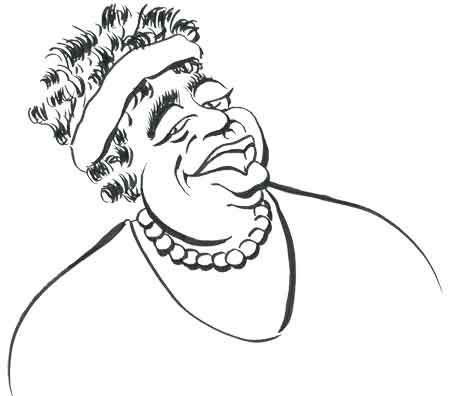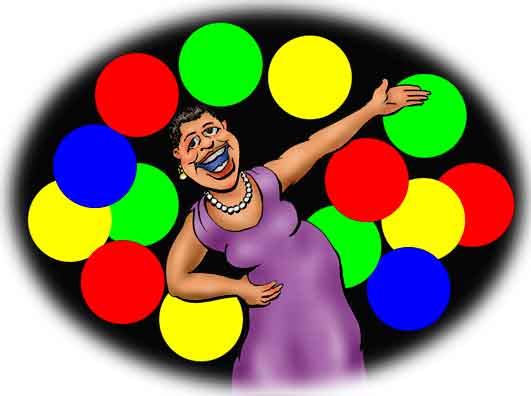Ma Rainey

When learning about one historically important figure, one oft times comes across another. And when studying about the "Queen of the Blues" Bessie Smith (some say the "Empress") the student will inevitably learn about Gertrude Pridgett "Ma" Rainey. And you'll read that if Bessie was the Queen or Empress of the Blues, Ma Rainey was indeed the Mother of the Blues.
Ma is usually spoken of as a mentor and mother-figure to Bessie, who as a young woman had joined the traveling show run by Ma and her husband William Rainey ("Pa", of course). Bessie was in the chorus (as we say today) and under Ma's tutelage, Bessie emerged a principal solo blues singer. But equally important is that Ma - a shrewd business woman - is said to have ingrained into Bessie the economics of the business.

Bessie
She was influenced.
However such a straightforward picture may not be quite so straightforward. Bessie in her later years tended to pooh-pooh the suggestion that Ma was crucial to her success. But it's certainly true that Ma helped Bessie get her career going. Ma, though, was only about six years Bessie's senior and so maybe a better allusion is that she played the part of a big sister. But that Ma influenced Bessie isn't to be doubted even though by 1914 Bessie was out performing on her own.
Ma was born in 1886 in Columbus, Georgia1, and like Bessie, she started singing as a young girl. After all, if you wanted music in the early 1900's, you made it yourself or had people perform live for you.
Footnote
One of the most popular information websites mentions Ma may have been born in 1882. However, most scholars agree it was 1886.
Professionally Ma got off to an early start and at age 14 she was performing in revues and traveling shows. She later told a musicologist that she first heard the blues in 1902 and adopted the songs in her act. Some have questioned what appears to be a sudden appearance of the now popular musical genre since the blues didn't just show up but instead was a development over many decades from the work songs of the slaves from the ante-bellum Civil War. But by the first decade of the 20th century, Ma was certainly singing the blues.
Although performing was a better job than working on the farms, it wasn't without its hazards. Once Ma was on stage singing a song with the lyrics:
If you don't believe I'm sinking,
Look what a hole I'm in.
At the last line the stage collapsed dropping Ma through. Fortunately, she wasn't hurt.
Ma and Pa had gotten married in 1904. As was common, their company would tour mostly after the harvests when the workers had more time on their hands. But when cold weather hit - yes, it does get cold in the South - they spent the winters in New Orleans. There they met and performed with the newly emerging jazz groups - then often spelled "jass".
By all accounts, Bessie could be a fiery girl, with a temper and who liked to party. Ma, though, was more sedate although she didn't let people "talk over her" as it was called. Still others remember Ma could be pretty feisty, too. One performer mentioned Ma could swear up a blue streak if the cause arose. "But she never cussed me out," he added.
By 1918 the marriage of Ma and Pa had slud out (to borrow a phrase from Dizzy Dean). A few years later Pa died. By then, though, Ma was a star on the performing circuit, which took her to cities in the north, most notably Chicago which became (and remains) a center for the blues.
The scholarly consensus is that Mamie Smith was the first lady blues singer to record. But the truth is that after the First World War, the newly emerging recording industry took notice how the specialized musical genres were fodder for profit. The companies began recording blues in the early 1920's and tapped a number of artists at about the same time. In 1923, Ma was signed up with Paramount (the record company and not to be confused with the later film studio) and eventually she turned out almost 100 sides. She recorded with a number of artists that are now legendary including a skinny young trumpet player named Louis Armstrong.

Louie
(Skinny and Legendary)
One critic described Ma's voice as "gravely". Actually the records - although usually not of the best technical quality - sound like she had a contralto range. In any case, her voice is actually pretty smooth and "gravely" seems a bit overcritical.
The Great Depression plus the emergence of radio put a strain on the recording industry. No longer were the executives sending scouts out to find new talent but instead they preferred to keep with the tried and true stars. Mainstream tastes had also changed and the 1930's saw the rise of the Big Band Swing Era. Some black musicians adapted - Duke Ellington and Count Basie - but others returned to more local touring or retired outright.
Ma returned to Georgia in 1935. She kept performing but spent much of her time as an impressario in charge of local theaters and entertainment. Sadly she lived only four more years, dying at age 53 in 1939.
References
Mother of the Blues: A Study of Ma Rainey, Sandra Lieb, University of Massachusetts Press, 1981.
Ma Rainey and the Classic Blues Singers, Derrick Stewart-Baxter, Stein and Day, 1970.